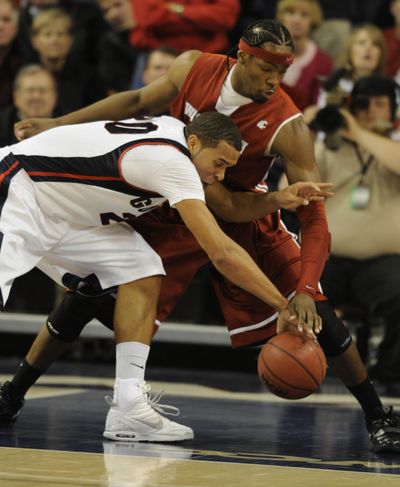Cougars count on Casto to shore up inside defense

PULLMAN – DeAngelo Casto knows it’s what he has to do. That doesn’t mean he likes it.
The “it” is planting his 6-foot-8, 241-pound body into the paint every night of the Pac-10 basketball season and absorbing the blows of taller, larger, bigger post players.
“If you really want the truth,” Casto said, “I’m not looking forward to it. I realize I’m an undersized big, even across the nation, so every night, day in and day out, it’s going to be bang, bang, bang on my body, on my knees, on my shoulders, my head. My mouth takes a couple shots a game.
“But what can you do?”
In Casto’s case, what Washington State University expects him to do is hold down the middle of the defense – he’s blocked a Pac-10-best 27 shots this season and averages 7.3 rebounds – and score – he’s third on the Cougars, averaging 10.8 points a game.
That’s while giving up 2 or 3 inches and 5 to 10 pounds to most players he guards.
Take tonight, for instance. The Oregon Ducks will fly into Beasley Coliseum on a four-game winning streak powered in part by the inside play of 6-10, 242-pound Michael Dunigan and 6-8, 250-pound Josh Crittle, both, like Casto, sophomores.
And they hope to have 6-6, 237-pound Joevan Catron back after the senior missed the last eight games with a back injury.
“They have some big kids who are big, just literally big,” WSU coach Ken Bone said. “They’re much bigger than our bigs.”
Besides Casto at the post, the Cougars start 6-7, 200-pound Abe Lodwick at the power forward spot. When Lodwick sits, 6-6, 221-pound Nik Koprivica comes off the bench, followed by 6-9, 205-pound Brock Motum.
Casto’s backups are 6-10, 222-pound Charlie Enquist and 6-7, 213-pound James Watson, none of whom will be mistaken for Shaq.
That puts even more pressure on Casto, as the muscle in the middle, to stay in the game.
“He’s become a little more experienced,” Bone said of Casto’s ability to stay out of foul trouble. “It’s him maturing as a player and understanding his role and being more intelligent on the floor.”
Casto hasn’t had a problem with fouls this season, in part because he’s picking his spots to attack shooters even better; in part because, coming off offseason knee surgery, his minutes were limited early in the year; and in part because the rest of the Cougars (10-2) have rebounded well enough to keep opponents from getting too many second-chance looks close to the basket.
The Ducks (8-4) do a good job running down offensive rebounds, but their offense plays a role in that.
Despite the size inside, Oregon loves to shoot the 3-point shot, especially in transition. Long shots – UO has 215 3-pointers – lead to long rebounds, which wings like Jamil Wilson (a team-high 22 offensive boards) and Teondre Williams (19) run down.
“Oregon has some guys who are capable of going off for some big numbers,” Bone said. “(Monday) night, (Tajuan Porter) hit 5 out of 7 from the 3-point line. … (Malcolm) Armstead can put up some numbers also.”
The 5-7 Porter, who missed four games with a sprained ankle, is playing off the ball more this season and leads the Ducks in scoring, averaging 11 points a game. He’s shooting 37.3 percent from behind the arc and has taken a team-high 51 shots from there.
Armstead, a junior college transfer who has taken over at the point, has hit half his 22 3-pointers and scored a career-high 23 against Idaho State a little more than a week ago.